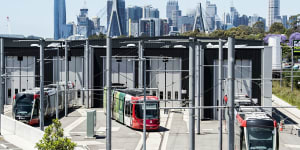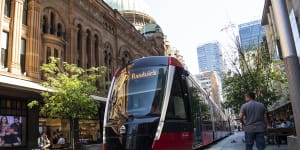After forced the closure of the inner west line for months,the state’s transport agency has revealed it is in discussions with the private consortium responsible for the inner west and the CBD and eastern suburbs lines about the “option of a mixed fleet operation”.

The inner west and CBD and eastern suburbs light rail lines have different types of trams.Steven Siewert
Transport for NSW chief operations officer Howard Collins said integrating the lines was “worthy of consideration” as it would bolster the flexibility of operations.
“At the moment ... we cannot do[a mixed-fleet operation] because we have one tram line with a tram wheel profile and one with a heavy rail profile,” he said.
The agency is awaiting a proposal from the ALTRAC consortium,which is the contractor for the inner west and CBD and eastern suburbs lines. French company Transdev,which is part of the consortium,operates trams that differ in length and width on the two lines.
Tram services on the 12.8-kilometre inner west line between Central Station and Dulwich Hill were,after sizeable cracks were discovered in the 12-vehicle Urbos fleet.

The trams used on the CBD and eastern suburbs light rail line are different to those on the inner west line.Louise Kennerley
However,the inner west in February when six Citadis trams were borrowed from the CBD and eastern suburbs light rail line,after modifications to station platforms,track,and changes to speed limits were made to accommodate them.
The CBD and eastern suburbs trams are slightly narrower,creating a greater distance between the vehicle and the platform on the inner west line,which has meant a temporary “gap filler” was needed on platforms for the Citadis trams to carry passengers.
While operating Citadis trams permanently on the inner west line would improve operations,the agency declined to say whether it was keen for the Urbos fleet to run on the CBD and eastern suburbs line. Even if that did occur,the inner west trams could not be used on a section of track along George Street in the CBD because it does not have overhead wires.
Tram expert and former Labor government transport adviser Greg Sutherland said the lines could be integrated but the tracks and tram wheels would need to be modified. “It can be rescued,but you are going to have to spend money to rescue it,” he said.
Mr Sutherland said the differences between the lines highlighted the need for authorities to draw up the same standards for the entire tram network,including the and light rail lines.
Labor transport spokeswoman Jo Haylen said the difficulty for commuters to catch light rail from Dulwich Hill to Kingsford was due to the government’s failure to integrate Sydney’s tram network in the first place.
“The government and the transport department are still buying overseas made trams that can’t run on both of Sydney’s tram lines,” she said. “If they are serious[about integrating the lines],they need to immediately change their whole procurement strategy.”
Transport for NSW said that running a mixed fleet permanently on the inner west line would provide more flexibility and resilience during major maintenance,as well as provide an option for extra capacity for major events. “To be able to run mix fleet long term,there is significant engineering and safety assurance work that would need to occur,” it said.
The agency cited the need for modifications to the track,wheel profiles and platforms,adjustments to the communication and control systems,and changes to operations and maintenance. It is understood that Transport for NSW has not received a formal proposal from ALTRAC.
The inner west trams were made by Spanish manufacturer CAF,whereas those used on the $3.1 billion CBD and eastern suburbs light rail line were built by French company Alstom.
Mr Collins said the agency was aiming for six of the 12-strong inner west fleet,as well as a spare,to be back in service by the end of June. The repairs to the rest of the inner west line’s fleet were expected to be complete by the end of October.
Four new trams the government had ordered to bolster the size of the inner west light rail fleet were still on track to be delivered next year,he said. Their aluminium design is different to the existing trams.
The Morning Edition newsletter is our guide to the day’s most important and interestingstories,analysis and insights.